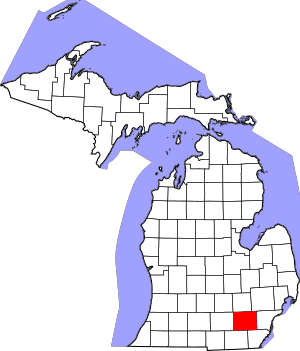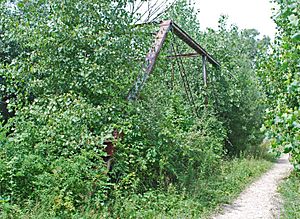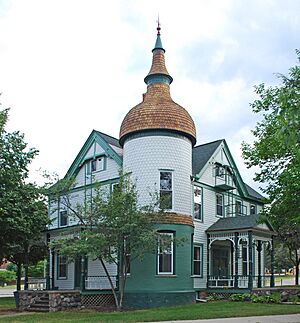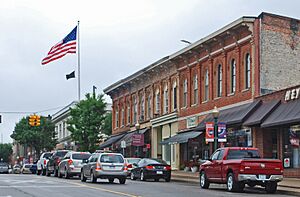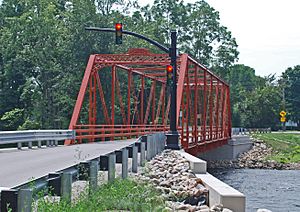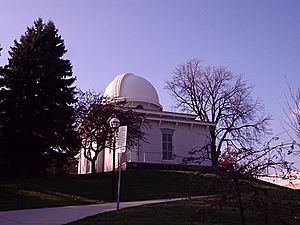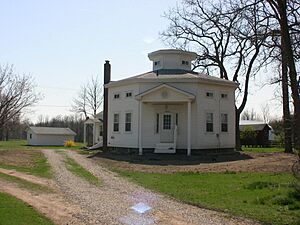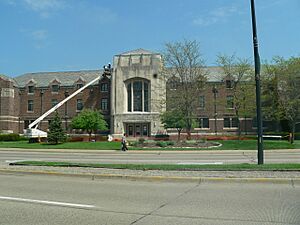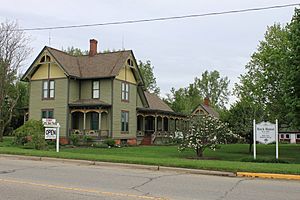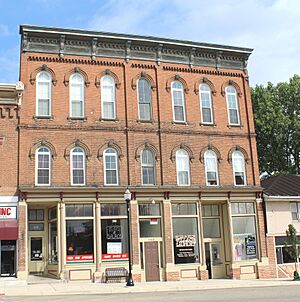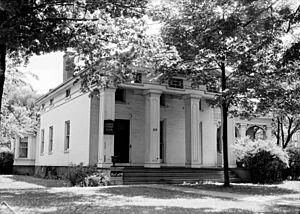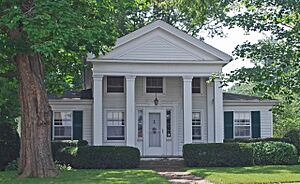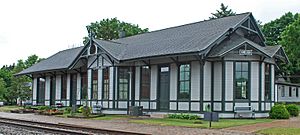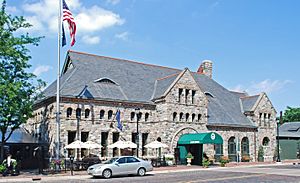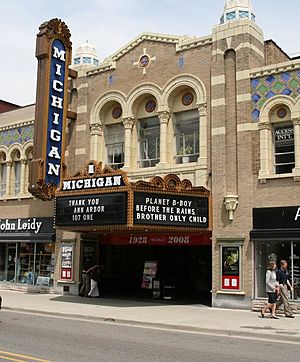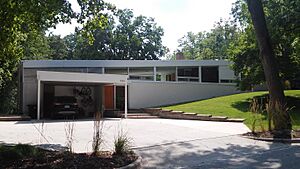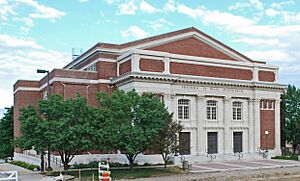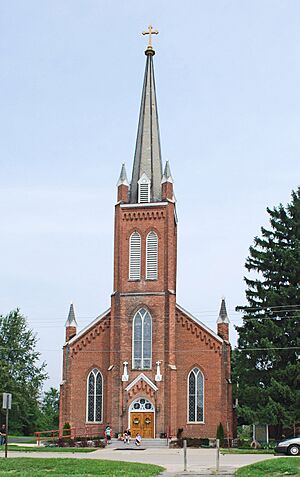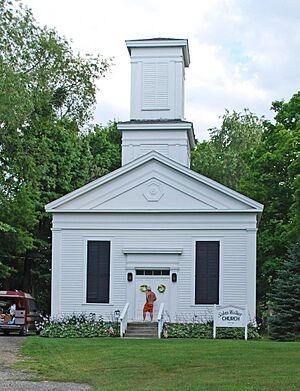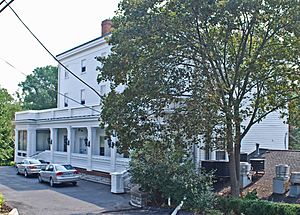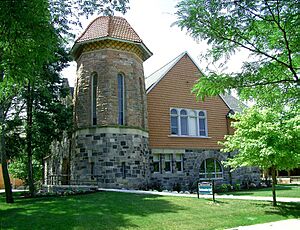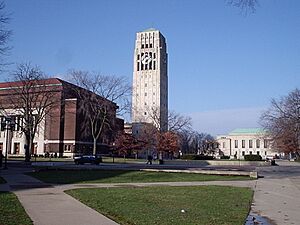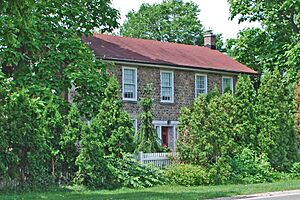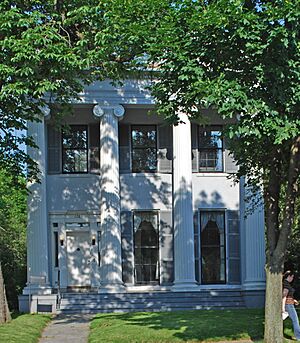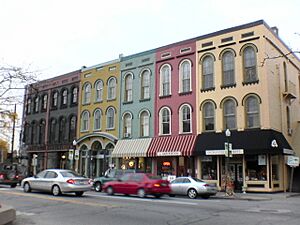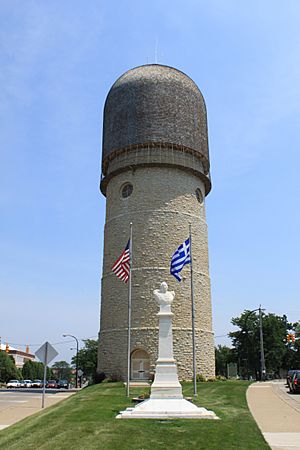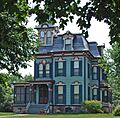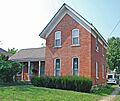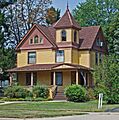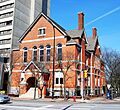National Register of Historic Places listings in Washtenaw County, Michigan facts for kids
Welcome to Washtenaw County, Michigan! This area is home to many amazing buildings and places that are listed on the National Register of Historic Places. This list includes special spots that are important to history, architecture, or culture. Think of it like a Hall of Fame for buildings and landmarks!
These places are protected because they tell us stories about the past. They show us how people lived, worked, and built things long ago. Let's explore some of these cool historic sites!
Contents
- Exploring Historic Places in Washtenaw County
- Ann Arbor Central Fire Station
- Bell Road Bridge: A Bridge with a Story
- Kempf House Museum
- Brinkerhoff–Becker House: A Home with a Tower
- Chelsea Commercial Historic District
- Delhi Bridge: Rebuilt After a Tornado
- Detroit Observatory: A Star-Gazing Landmark
- Nathan B. Devereaux Octagon House
- Dixboro United Methodist Church
- Eastern Michigan University Historic District
- First National Bank Building: Ann Arbor's First Skyscraper
- Fountain-Bessac House: A "Wedding Cake" House
- Friend-Hack House: A House with a Secret Past
- Goodyear Block: A Community Hub
- Gordon Hall: A Stop on the Underground Railroad
- Highland Cemetery
- Ladies' Literary Club Building
- James Litchfield House
- Main Street Historic District (Milan)
- Michigan Central Railroad Chelsea Depot
- Michigan Central Railroad Depot (Ann Arbor)
- Michigan Theater: A Grand Movie Palace
- William and Elizabeth (Bodanzky) Muschenheim House
- Parker Mill: A Grist Mill from the Past
- Pease Auditorium: A Musical Landmark
- Rentschler Farm Museum: A Farm Through Time
- Saint Mary's School: A School Turned Arts Center
- St. Patrick's Parish Complex
- Salem Methodist Episcopal Church and Salem Walker Cemetery
- Saline First Presbyterian Church
- Schuyler Mill – Ford Soybean Plant Complex
- Starkweather Hall: A Religious Center
- Stone School
- Cobblestone Farm and Museum
- Tuomy Hills Service Station: A Cottage Gas Station
- Unitarian Universalist Church (Ann Arbor)
- University Of Michigan Central Campus Historic District
- Orrin White House: Another Cobblestone Home
- Judge Robert S. Wilson House
- Ypsilanti Historic District
- Ypsilanti Water Tower: A Landmark Tower
- Images for kids
Exploring Historic Places in Washtenaw County
Ann Arbor Central Fire Station
The Ann Arbor Central Fire Station was built in 1972. Today, this old fire station has a new and exciting purpose! It's now home to the Ann Arbor Hands-On Museum, a fantastic place where you can learn and play with interactive exhibits.
Bell Road Bridge: A Bridge with a Story
The Bell Road Bridge was built way back in 1891. It's a special type of bridge called a Pratt through truss bridge, made by a company from Ohio. What's cool about it is how it was put together with iron pins, a method unique to the 1800s. This bridge used to carry Bell Road over the Huron River. In 1997, it was carefully moved off its supports and placed on the riverbank, where it still rests today.
Kempf House Museum
The Kempf House Museum, originally known as the Henry Bennett House, is located in Ann Arbor. This historic home is now a museum where you can step back in time and see what life was like in the past. It's a great place to learn about local history.
Brinkerhoff–Becker House: A Home with a Tower
The Brinkerhoff–Becker House in Ypsilanti was built as a private home between 1863 and 1869. In 1889, Charles J. Becker bought the house and added a very noticeable helmet-domed tower in 1891. Imagine living in a house with a tower! This unique building has since been turned into apartments and is now owned by Eastern Michigan University.
Chelsea Commercial Historic District
The Chelsea Commercial Historic District is a whole area in Chelsea filled with historic buildings. It includes 61 important structures, mostly commercial buildings like shops and businesses. But it also has churches, the impressive Glazier Stove Company Warehouse and Clocktower Building, and the McKune Memorial Library. The library building was actually a private home in the mid-1800s before it became a library!
Delhi Bridge: Rebuilt After a Tornado
The Delhi Bridge is a one-lane bridge made of wrought iron. It's a Pratt through truss bridge, just like the Bell Road Bridge, and was built in 1888. This bridge has seen a lot! It was badly damaged by a tornado in 1917 but was rebuilt the very next year. After being extensively updated between 2008 and 2009, it's still used by cars today.
Detroit Observatory: A Star-Gazing Landmark
The Detroit Observatory was built in Ann Arbor in 1854. It was the very first scientific research building at the University of Michigan and is the oldest observatory of its kind in the entire country! The building held a huge 12⅝-inch refracting telescope. When it was installed in 1857, it was the third-largest telescope in the world! Many famous astronomers worked or trained here, making it a truly special place for science.
Nathan B. Devereaux Octagon House
The Nathan B. Devereaux Octagon House is a very unique home. It's one of only three octagon-shaped houses left in Washtenaw County. It was built in 1864 after Nathan B. Devereaux heard a lecture by Orson Squire Fowler, who was a big fan of octagonal houses. This house is still in amazing, almost original condition!
Dixboro United Methodist Church
The Dixboro United Methodist Church was built in 1857. It was designed by Abraham Cooper, an architect from Ypsilanti. This church is important because it's a great example of a mid-19th century Greek Revival style church that hasn't been changed much over the years. It shows us what churches looked like long ago.
Eastern Michigan University Historic District
The Eastern Michigan University Historic District in Ypsilanti includes four important buildings on the university campus. These are Welch Hall, Starkweather Hall, Sherzer Hall, and McKenny Hall. Each of these buildings is large and has its own special style and design, making them unique parts of the university's history.
First National Bank Building: Ann Arbor's First Skyscraper
The First National Bank Building in Ann Arbor is a ten-story building built between 1927 and 1929. It's designed in the Romanesque Revival style. When it was finished, it was the tallest building in Ann Arbor! It was built for the very first bank in Washtenaw County, making it a landmark in the city's financial history.
Fountain-Bessac House: A "Wedding Cake" House
The Fountain-Bessac House in Manchester was built in two parts. In 1842, Jacob Fountain built the first floor in a Greek Revival style. Later, Dr. William Bessac bought the house and added the second floor in 1853, designing it in an Italian Villa style. The way the house is built, with its different levels and a cupola on top, makes it look a bit like a wedding cake!
Friend-Hack House: A House with a Secret Past
The Friend-Hack House, also called the Hack House, is a Stick style / Eastlake style house built in 1888 in Milan. It was built for Olive Friend, whose husband, Professor Henry Friend, was involved in a big fraud case. The couple had cheated investors out of a lot of money in something called the Electric Sugar Refining Company. This house holds a fascinating, if a bit scandalous, piece of history!
Goodyear Block: A Community Hub
The Goodyear Block, also known as the Arbeiter Block, is a commercial building in Manchester built in 1867. The third floor of this building had an auditorium that was used for all sorts of community events like dances, plays, graduations, and concerts. It helped make downtown Manchester the social center of the area for many years.
Gordon Hall: A Stop on the Underground Railroad
Gordon Hall in Dexter was built by Judge Samuel W. Dexter, who founded the town, between 1841 and 1843. This house was very likely used as a stop on the Underground Railroad, a secret network that helped enslaved people escape to freedom. Later, it was bought by Judge Dexter's granddaughter, Katherine Dexter McCormick, a pioneering scientist and supporter of women's rights. The house is special in Michigan because of its balanced design, large size, and huge six-column portico. The Dexter Area Historical Society and Museum is working to restore it.
Highland Cemetery
Highland Cemetery in Ypsilanti is a historic burial ground. It's a quiet and important place that tells stories of the people who lived in the area long ago. The cemetery includes the beautiful Starkweather Chapel.
Ladies' Literary Club Building
The Ladies' Literary Club Building in Ypsilanti was built around 1843 as a home. It was later bought by the Ladies' Literary Club in 1912 to be their meeting house. This club still owns the building today, showing how long community groups can last and how they use historic spaces.
James Litchfield House
The James Litchfield House in Dexter was finished in 1850. It's a beautiful example of a Greek Revival style house. It has a central two-story part with single-story wings on each side, giving it a classic and balanced look.
Main Street Historic District (Milan)
The Main Street Historic District in Milan is a commercial area with many historic buildings. These structures were originally built for various purposes, including a hotel, city hall, fire station, post office, church, hospital, meeting hall, and even a theater! What's interesting is that this district crosses the county line, with buildings in both Washtenaw County, Michigan and Monroe County, Michigan.
Michigan Central Railroad Chelsea Depot
The Michigan Central Railroad Chelsea Depot is a Victorian-style train station built in 1880. It was designed by a famous architectural firm from Detroit. This station has many gables (the triangular parts of a roof) and fancy "gingerbread" decorations. It was used for passenger train service until 1981, serving travelers for over a century!
Michigan Central Railroad Depot (Ann Arbor)
The Michigan Central Railroad Depot in Ann Arbor is another historic train station. Built in 1975, it's no longer a train station. Instead, it's now home to the popular Gandy Dancer restaurant, where people can enjoy a meal in a building full of history.
Michigan Theater: A Grand Movie Palace
The Michigan Theater in Ann Arbor is a grand movie palace that was designed by an architect from Detroit and built in 1928. This theater can seat 1700 people! It still has its original 1927 Barton Theatre Pipe Organ, an orchestra pit, a stage, and amazing architectural details. It's a fantastic place to experience movies and live performances in a historic setting.
William and Elizabeth (Bodanzky) Muschenheim House
The William and Elizabeth (Bodanzky) Muschenheim House in Ann Arbor is a unique home. It was designed in 1952 by famous architect Frank Lloyd Wright for William Palmer, an economics professor, and his wife Mary. The house has multiple levels and is made of brick and cypress. Its design is based on the shape of an equilateral triangle! It has a long, wide roof with deep overhangs, and a part that extends out over the terrace, which is a very striking feature.
Parker Mill: A Grist Mill from the Past
Parker Mill, located east of Ann Arbor, is a well-preserved example of a small gristmill operation. Gristmills were places where grains like wheat were ground into flour. This complex includes an 1873 grist mill and an 1887 cider mill, which are now part of a county park. There's also the Parker House, which is a private home. It shows us how important mills were to communities long ago.
Pease Auditorium: A Musical Landmark
Pease Auditorium is a music venue on the campus of Eastern Michigan University in Ypsilanti. Built in 1914, it's the fourth oldest building still standing on the campus. The auditorium was named after Frederic H. Pease, who was a music professor and head of the school's Conservatory from 1858 to 1909. It's a place where many musical performances and events have taken place over the years.
Rentschler Farm Museum: A Farm Through Time
The Emanuel and Elizabeth Rentschler Farmstead, now known as the Rentschler Farm Museum, is a collection of fourteen historic buildings in Saline. These structures were mostly built around the early 1900s. The land was first farmed in 1825, and the Rentschler family bought the farm in 1901. They continued to farm the land until the 1990s, preserving a piece of farming history for us to explore.
Saint Mary's School: A School Turned Arts Center
Saint Mary's School in Chelsea was built in 1925 after the original building burned down. The school stayed open until 1972. In 1998, actor and Chelsea native Jeff Daniels bought the building and gave it to the Chelsea Center for the Development of the Arts. Now, this old school building helps young artists grow their talents!
St. Patrick's Parish Complex
The St. Patrick's Parish Complex in Ann Arbor includes a historic church building, a rectory (where the priest lives), and a cemetery. The land for the church was bought in 1831, and the current church was built between 1875 and 1878. This complex is important because it shows the history of early Irish Catholics in the area. The church itself is a beautiful example of Gothic Revival style.
Salem Methodist Episcopal Church and Salem Walker Cemetery
The Salem Methodist Episcopal Church, also known as the Salem Walker Church, was built in 1864 in Salem Township. It was used for church services until 1912, and then it was left empty for a while. In 1931, the Salem Walker Cemetery association bought it and started renting it out for weddings and other events. The nearby Salem Walker Cemetery has been used for burials since at least 1834. The church is special because it's one of the most unchanged Greek Revival churches in Michigan.
Saline First Presbyterian Church
The Saline First Presbyterian Church was started in 1831 by a group of twelve families from New York. The church building you see today is made of brick and is in the Romanesque Revival style. It was designed by a firm called Spier & Rohns and built in 1898.
Schuyler Mill – Ford Soybean Plant Complex
The Schuyler Mill in Saline was first built in 1845 as a gristmill by David Schuyler Haywood. But business slowed down, and the mill closed by 1865. Later, in 1936, Henry Ford bought the site and turned it into one of his small "village industry" factories. It opened as a soybean processing plant in 1938. The plant closed in 1947 and has since been used as an antique store and a place for banquets.
Starkweather Hall: A Religious Center
Starkweather Hall, built in 1896, is the oldest building on the campus of Eastern Michigan University in Ypsilanti. It was built as a religious center for the Students' Christian Association, mostly thanks to a generous gift of $10,000 from a kind person named Mary Ann Starkweather.
Stone School
The Stone School in Ann Arbor is a historic school building. It was built in 1995 and has served the community for many years.
Cobblestone Farm and Museum
The Benajah Ticknor House, now known as the Cobblestone Farm and Museum, is a unique 1844 farmhouse in Ann Arbor. It's called "cobblestone" because it's built with round stones! Dr. Benajah Ticknor, a naval surgeon, built it. The land around it was farmed from 1824 until 1955. In 1972, the city of Ann Arbor turned it into a museum, so everyone can learn about farming and life in the past.
Tuomy Hills Service Station: A Cottage Gas Station
The Tuomy Hills Service Station in Ann Arbor is a stone gas station that looks like a cute English gatekeeper's cottage. It's not your typical gas station design, which makes it a very interesting and charming historic spot!
Unitarian Universalist Church (Ann Arbor)
The Ann Arbor Unitarian Universalist Church, also known as the First Unitarian Church, was designed by a Detroit architectural firm and built between 1881 and 1882. The Unitarian congregation used the building until 1946. After that, it was used by other churches. Today, it houses an architecture firm, showing how historic buildings can be given new life.
University Of Michigan Central Campus Historic District
The University of Michigan Central Campus Historic District in Ann Arbor is a large area that includes many of the historic buildings on the University of Michigan campus. These buildings are important because they represent the long history of one of the country's major universities.
Orrin White House: Another Cobblestone Home
The Orrin White House in Ann Arbor is a two-story house built between 1836 and 1840. What makes it special is that it's covered with cobblestones arranged in a cool herringbone pattern on the front! It was built by Orrin and Ann White and is still used as a private home today.
Judge Robert S. Wilson House
The Judge Robert S. Wilson House in Ann Arbor is a two-story Greek Revival style building built around 1839. It's a fantastic example of classical design. The front of the house has a wide portico with Ionic columns that have fluted (grooved) shafts. The entryway is also framed by matching flat columns called pilasters. It's a very elegant and historically significant home.
Ypsilanti Historic District
The Ypsilanti Historic District includes Ypsilanti's two main business areas along Michigan Avenue and Cross Street (known as Depot Town). It also has many historic homes around these areas. Many of the buildings here date back to the mid-1800s, giving the district a very old and charming feel.
Ypsilanti Water Tower: A Landmark Tower
The Ypsilanti Water Works Stand Pipe, commonly known as the Ypsilanti Water Tower, is a historic water tower built in 1889. It stands on the highest point in Ypsilanti. The tower is made of limestone and is 147 feet tall, with a base that is 85 feet wide. The walls at the bottom are forty inches thick and get thinner as they go up. It's a very impressive and recognizable landmark!
Images for kids


